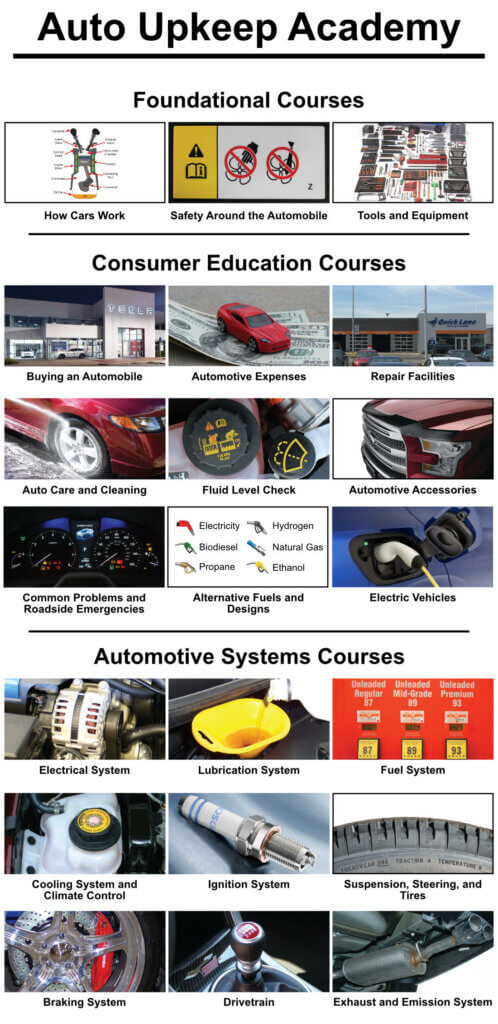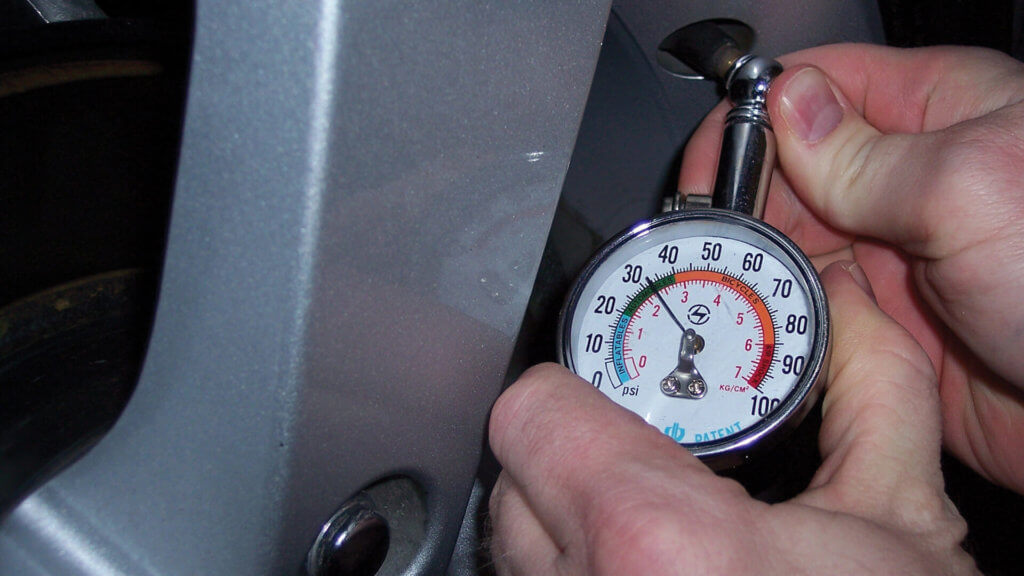Homeschools
Have your teens been asking for a fun and practical homeschooling elective?
Auto Upkeep is ideal for
-
Homeschool Co-ops
-
Understanding How Cars Work
-
Saving Money on Maintenance and Repairs
-
New Drivers
-
Supplementing Driver's Education
-
Knowing How to Keep a Vehicle Reliable
-
Learning How to Handle Roadside Emergencies
-
Determining a Budget that Works
-
Communicating Effectively with Technicians
- Homeschool Co-ops
- Understanding How Cars Work
- Saving Money on Maintenance and Repairs
- New Drivers
- Supplementing Driver's Education
- Knowing How to Keep a Vehicle Reliable
- Learning How to Handle Roadside Emergencies
- Determining a Budget that Works
- Communicating Effectively with Technicians
The Old Schoolhouse® Magazine Review
When I first thought about this course, I envisioned this being more of a father son project, but I ended up being the one who participated in these labs. They were great! I am not a “technical” person at all and that’s just the point. This course is for everyone. In fact, I think it was created with people like me in mind especially. The text is so easy to follow and learn from, that a person who feels quite out of their element in a mechanical situation can now be more at ease!
Amy Christy
The Old Schoolhouse® Magazine Review
Popular Options for Homeschoolers
We have multiple options to teach the curriculum. The content is very similar in each option, just delivered in different ways.
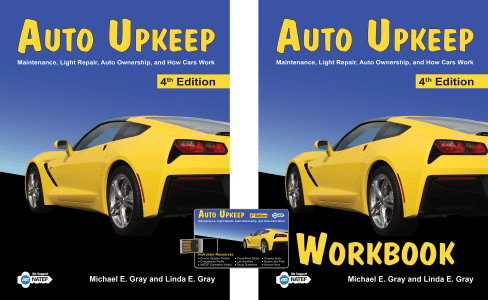
Homeschool
Auto Upkeep (4th Edition © 2018) – Homeschool Curriculum Kit
$69.00 – $87.00
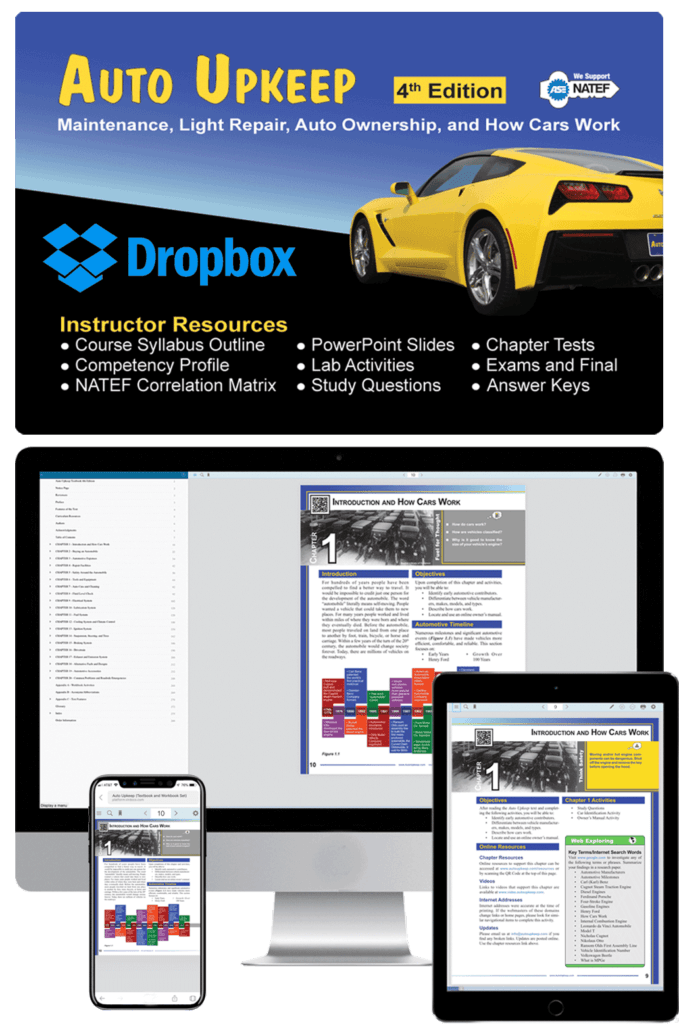
Homeschool
Auto Upkeep (4th Edition © 2018) – Homeschool Virtual Curriculum Kit
$55.00
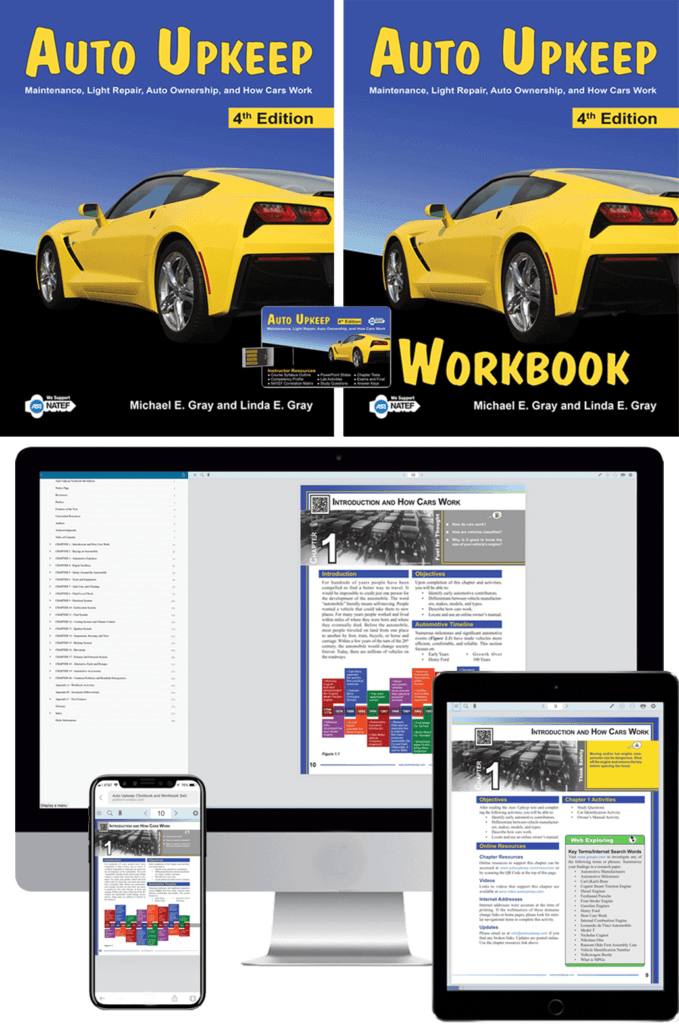
Homeschool
Auto Upkeep (4th Edition © 2018) – Homeschool Kit with eBook Set
$86.00 – $104.00
Options Explained
Option 1: Homeschool Curriculum Kit (Traditional Print)
$69.00 to $87.00 –> Buy Now
With the Homeschool Curriculum Kit, you get a textbook, workbook, and an Instructor USB. The USB features the following: Course Syllabus Outline, Competency Profile, ASE Education (NATEF) Correlation Matrix (Correlates to the Maintenance and Light Repair Task List), PowerPoint Slides, Lab Activities, Study Questions, Chapter Tests, Exams/Final, and Answer Keys.
Option 2: Virtual Curriculum eKit
$55.00 –> Buy Now
The Virtual Homeschool Curriculum eKit includes an eTextbook/eWorkbook and then access to the same files from the Instructor USB but through a Dropbox link. The tests would still need to be administered and graded by you, similar to the print kit. The answer keys would be provided to you through the Dropbox link. Think of the virtual curriculum ekit the same as the print kit, but using an eBook instead. The eBook looks just like the print book, but viewed on a screen.
Option 3: Homeschool Kit with eBook Set
$86.00 to $104.00 –> Buy Now
The Homeschool Kit with eBook Set is a combination of Option 1 and Option 2. This is ideal for learners that like print books but also like the option to access the eBook for their tablet, iPad, phone, or computer.
Option 4: Online Academy
$75.00 –> Buy Now
The Online Academy option is more web-based than Option 2. The content is delivered in a web-based interactive format instead of in a static eBook.
Features include:
- Interactive Lessons
- Embedded Videos
- Printable Course Certificates
- Graded Online Tests
- Student Transcripts
- Downloadable Activities
- Audio recordings of the text are in a human voice.
The tests in the Academy are instantly graded. The Online Academy is self-directed for students. Students can pick and choose the activities that they want to complete.
Automotive Homeschool Elective
Complete Homeschool Curriculum Kit
The Auto Upkeep Homeschool Curriculum Kit has the resources you need to homeschool your high school student on maintenance, light repair, auto ownership, and how cars work. Help them become confident automotive consumers!
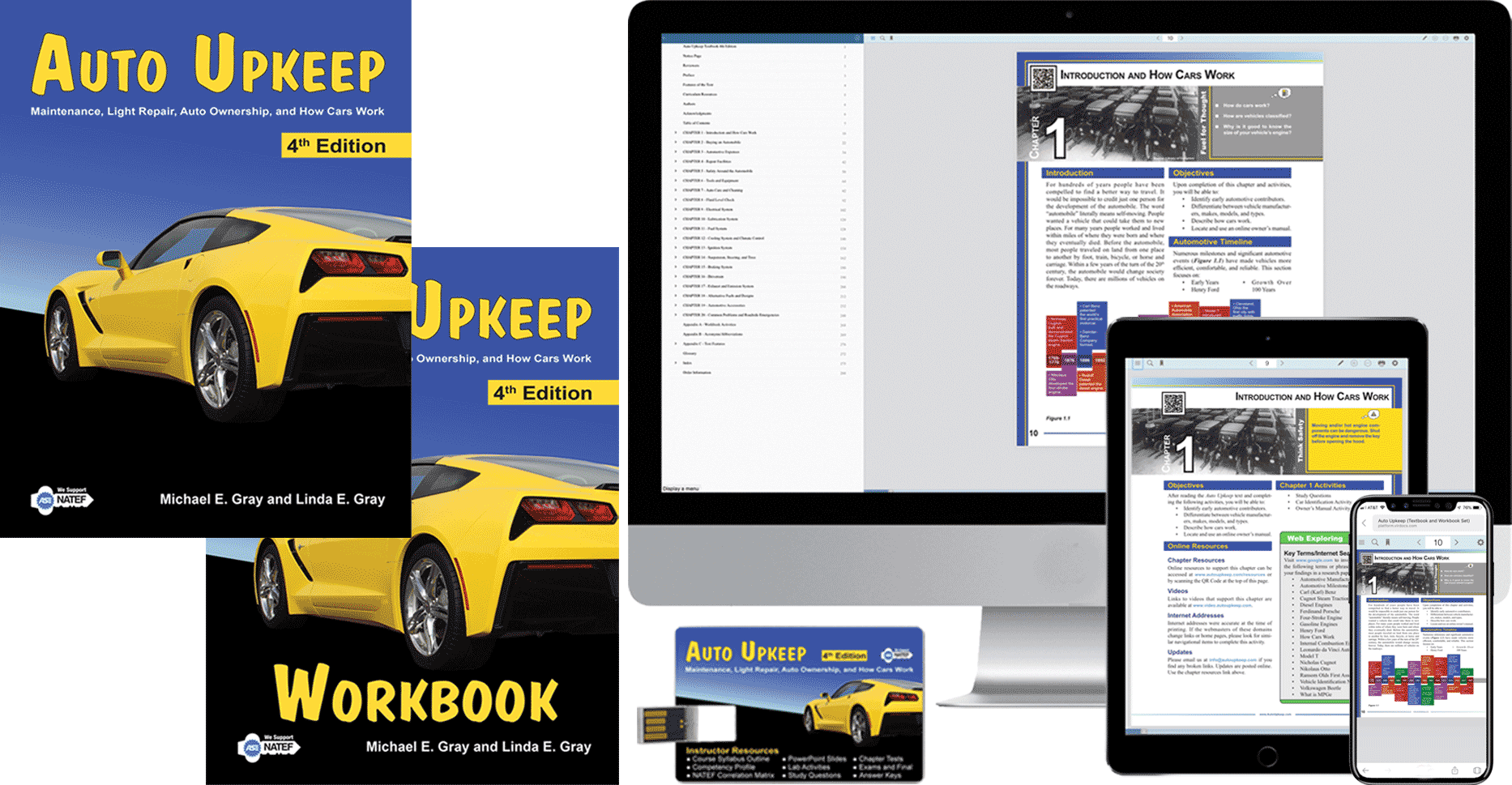
Auto Upkeep Textbook
• 288 FULL COLOR Pages
• 20 Easy-to-Read Chapters
• Over 700 Illustrations
• Hardcover and Paperback
Auto Upkeep Workbook
• 176 FULL COLOR Pages
• 40 Hands-on and Internet-based Activities
• Over 250 Illustrations
Instructor Resource USB
• Course Syllabus Outline
• ASE Ed (NATEF) & TEKS Correlations
• PowerPoints Presentations
• Lab Activities
• Study Questions
• Chapter Tests (LMS Compatible)
• Exams/Final (LMS Compatible)
• Answer Key
Auto Upkeep eBook (RedShelf eReader)
• Access on Any Device with Internet
• Rent or Buy
• Highlight and Take Notes Digitally
• Enhanced Navigation
• Keyword Search
• Create Flashcards and Study Guides
• Collaborate with Peers
Auto Upkeep Online Academy
Auto Upkeep is also now available as an all-in-one online solution where students have incentives to log in each day, complete interactive gamified content, and advance through the program. Students earn certificates for each course completed.
Learn more about the Online Academy.

Auto Upkeep Online Academy
• Access on Any Device with Internet
• All 20 Courses
• All 40 Activities
• Graded Tests
• Interactive Lessons
• Gamified Design
• Connected Community
• Collaborate in Groups
An Elective Your Teen Will Love
Education is a pathway to success. Our children learn best by doing. Hands-on learning is a great way to keep the attention of students, especially teenagers. Students love Auto Upkeep because what they are learning applies to their life. Auto Upkeep will help your teens become confident auto owners.
Flexible Curriculum
Best of all, you don’t need to be an auto technician or have an auto shop to perform these homeschool activities. Auto Upkeep, with its vast activity flexibility (40 activities to pick from), can be taught at home in the driveway or garage, with many activities Internet-based. Your child will most likely own a car…Auto Upkeep can expose them to practical experiences that will empower them for life. Auto Upkeep is designed as a 1 credit course elective. If you would like to run this as a 1/2 credit course, shorten the number of hours by reducing or eliminating the number of activities completed. See more information in the Homeschool FAQs.
40 Workbook Activities by Chapter
Chapter 1 – Introduction and How Cars Work
Car Identification Activity – Identify an automobile by make, model, year, and type.
Owners Manual Activity – Locate and use an online owners manual.
Chapter 2 – Buying an Automobile
Buying a New Automobile Activity – Differentiate between MSRP, dealer invoice, and dealer cost.
Buying a Used Automobile Activity – Research prices, reliability ratings, recalls, technical service bulletins, and safety ratings.
Chapter 3 – Automotive Expenses
Automotive Expenses Activity – Calculate automotive expenses.
Chapter 4 – Repair Facilities
Repair Facilities Activity – Choose a quality repair facility. Interpret a repair invoice.
Chapter 5 – Safety Around the Automobile
Automotive Safety Activity – Identify the location of emergency and safety equipment.
Safety Data Sheets – Locate and interpret a safety data sheet.
Personal Protection Equipment (PPE) and Fire Safety Activity – Identify the importance of using personal protection equipment and research fire safety.
Chapter 6 – Tools and Equipment
Tools and Equipment Activity – Identify basic tools and equipment that are used in automotive shops.
Service Manual Activity – Navigate an online service manual.
Chapter 7 – Auto Care and Cleaning
Interior Cleaning Activity – Clean the inside of a vehicle.
Exterior Cleaning Activity – Clean the outside of a vehicle.
Waxing Activity – Wax the finish on a vehicle.
Chapter 8 – Fluid Level Check
Fluid Level Check Activity – Safely check the fluid level in various vehicle components.
Chapter 9 – Electrical System
Ohms Law Activity – Use Ohms Law to calculate volts, amps, or ohms.
Wiring Diagram Activity – Locate and interpret a wiring diagram.
Battery Activity – Safely clean and test the battery.
Charging Activity – Safely test the alternator.
Starting Activity – Safely test the starter.
Chapter 10 – Lubrication System
Oil and Filter Change Activity – Safely change the oil and filter on a vehicle.
Chapter 11 – Fuel System
Fuel System Part Identification Activity – Use an online auto parts catalog to identify fuel system parts.
Fuel System Maintenance Activity – Change the air filter, PCV valve, and fuel filter.
Chapter 12 – Cooling System and Climate Control
Air Conditioning Activity – Inspect and identify the components within the air conditioning system.
Cabin Air Filter Activity – Replace the cabin air filter on a vehicle.
Cooling System Activity – Safely test, inspect, and service the cooling system. Observe thermostat operation.
Chapter 13 – Ignition System
Ignition System Activity – Install spark plugs. Inspect, test, and install spark plug wires. Inspect and install distributor cap and rotor on distributor systems.
Chapter 14 – Suspension, Steering, and Tires
Suspension and Steering Activity – Safely inspect and perform basic service procedures on suspension and steering components.
Tire Inspection and Rotation Activity – Safely inspect tires for wear and rotate tires.
Chapter 15 – Braking System
Brake Inspection Activity – Safely inspect disc brakes.
Chapter 16 – Drivetrain
Drivetrain Activity – Safely inspect drivetrain components.
Chapter 17 – Exhaust and Emission System
Exhaust and Emissions Activity – Safely inspect exhaust and emission components.
Chapter 18 – Alternative Fuels and Designs
Payback Period Activity – Calculate payback period.
Future Vehicle Activity – Predict the role of automobiles in 2050.
Chapter 19 – Automotive Accessories
Automotive Accessories Activity – Estimate the cost of accessories for a vehicle.
Chapter 20 – Common Problems and Roadside Emergencies
Changing a Flat Tire Activity – Safely change a spare tire.
Jump-Starting Activity – Safely jump-start a vehicle.
Lighting Activity – Replace various lights on a vehicle.
Replacing Wipers Activity – Replace wipers on a vehicle.
On-Board Diagnostics Activity – Retrieve diagnostic trouble codes (DTCs) from an OBD II system.
How to Use the Curriculum Kit
We created a roadmap to simplify the 6 steps to homeschooling with Auto Upkeep. Check out our "How to Teach Auto Upkeep" video.
From choosing an insurance policy to performing basic maintenance and repair, Auto Upkeep is the do-it-yourself automotive guide for the new driver in your family. Auto Upkeep helps keep your teen safe and vehicle reliable by providing easy-to-follow information with detailed pictures and drawings. Help your teen discover how to choose a quality repair facility, buy a car, handle roadside emergencies, perform basic maintenance, diagnose common problems, and communicate effectively with technicians – all while saving your family money.



